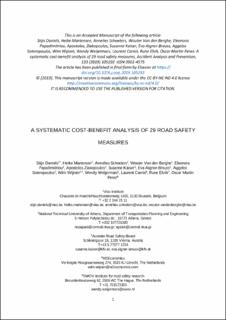| dc.contributor.author | Daniels, Stijn | |
| dc.contributor.author | Martensen, Heike | |
| dc.contributor.author | Schoeters, Annelies | |
| dc.contributor.author | Van den Berghe, Wouter | |
| dc.contributor.author | Papadimitriou, Eleonora | |
| dc.contributor.author | Ziakopoulos, Apostolos | |
| dc.contributor.author | Kaiser, Susanne | |
| dc.contributor.author | Aigner-Breuss, Eva | |
| dc.contributor.author | Soteropoulos, Aggelos | |
| dc.contributor.author | Wijnen, Wim | |
| dc.contributor.author | Weijermars, Wendy | |
| dc.contributor.author | Carnis, Laurent | |
| dc.contributor.author | Elvik, Rune | |
| dc.contributor.author | Perez, Oscar Martin | |
| dc.date.accessioned | 2021-03-22T14:08:56Z | |
| dc.date.available | 2021-03-22T14:08:56Z | |
| dc.date.created | 2019-10-22T12:45:04Z | |
| dc.date.issued | 2019-10-01 | |
| dc.identifier.citation | Accident Analysis and Prevention. 2019, 113 (December), . | en_US |
| dc.identifier.issn | 0001-4575 | |
| dc.identifier.uri | https://hdl.handle.net/11250/2734883 | |
| dc.description.abstract | Economic evaluations of road safety measures are only rarely published in the scholarly literature. We collected and (re-)analyzed evidence in order to conduct cost-benefit analyses (CBAs) for 29 road safety measures. The information on crash costs was based on data from a survey in European countries. We applied a systematic procedure including corrections for inflation and Purchasing Power Parity in order to express all the monetary information in the same units (EUR, 2015). Cost-benefit analyses were done for measures with favorable estimated effects on road safety and for which relevant information on costs could be found. Results were assessed in terms of benefit-to-cost ratios and net present value. In order to account for some uncertainties, we carried out sensitivity analyses based on varying assumptions for costs of measures and measure effectiveness. Moreover we defined some combinations used as best case and worst case scenarios. In the best estimate scenario, 25 measures turn out to be cost-effective. 4 measures (road lighting, automatic barriers installation, area wide traffic calming and mandatory eyesight tests) are not cost-effective according to this scenario. In total, 14 measures remain cost-effective throughout all scenarios, whereas 10 other measures switch from cost-effective in the best case scenario to not cost-effective in the worst case scenario. For three measures insufficient information is available to calculate all scenarios. Two measures (automatic barriers installation and area wide traffic calming) even in the best case do not become cost-effective. Inherent uncertainties tend to be present in the underlying data on costs of measures, effects and target groups. Results of CBAs are not necessarily generally valid or directly transferable to other settings. | en_US |
| dc.language.iso | eng | en_US |
| dc.publisher | Elsevier Ltd | en_US |
| dc.rights | Attribution-NonCommercial-NoDerivatives 4.0 Internasjonal | * |
| dc.rights.uri | http://creativecommons.org/licenses/by-nc-nd/4.0/deed.no | * |
| dc.title | A systematic cost-benefit analysis of 29 road safety measures | en_US |
| dc.type | Journal article | en_US |
| dc.type | Peer reviewed | en_US |
| dc.rights.holder | © 2019 Elsevier Ltd. All rights reserved. | en_US |
| dc.source.articlenumber | 105292 | en_US |
| dc.description.version | acceptedVersion | en_US |
| cristin.ispublished | true | |
| cristin.fulltext | preprint | |
| cristin.fulltext | original | |
| cristin.fulltext | postprint | |
| cristin.qualitycode | 1 | |
| dc.identifier.doi | 10.1016/j.aap.2019.105292 | |
| dc.identifier.cristin | 1739501 | |
| dc.source.journal | Accident Analysis and Prevention | en_US |
| dc.source.volume | 133 | en_US |
| dc.source.issue | December | en_US |
| dc.source.pagenumber | 13 | en_US |
| dc.relation.project | EC/H2020/633485 | en_US |

